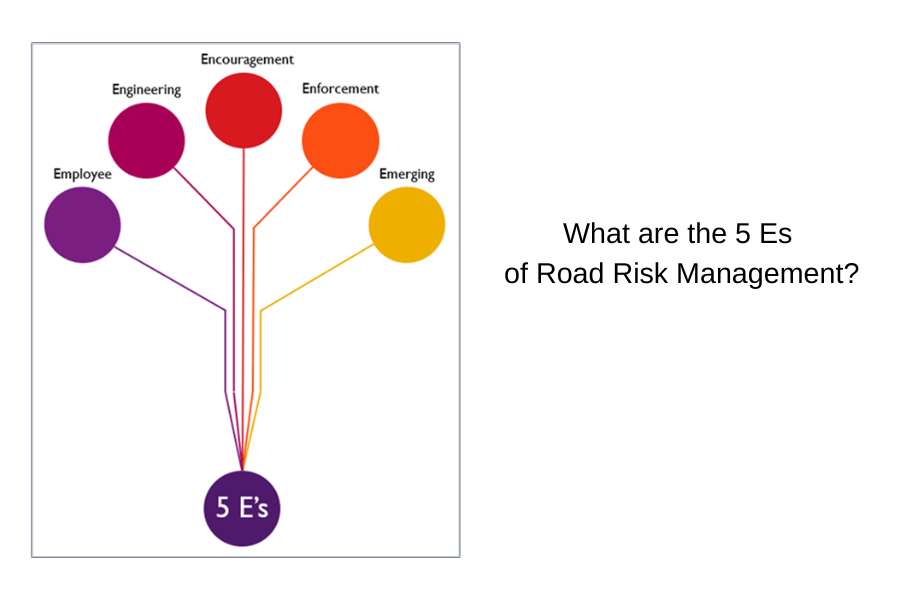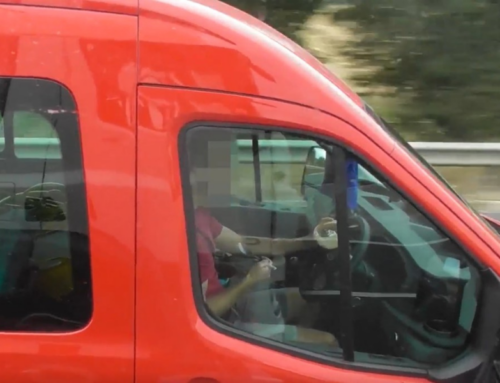This week’s guest article comes to us from Stefan Szrama GCGI, Road Safety Professional and Health, Safety and Environment Lead.
Enlisting into the British Army in 1988, Stefan completed 24 years’ service including time working as a Senior Specialist Vehicle Instructor at the Defence School of Transport (Europe’s largest driver training school). His final posting saw him responsible for the entire transport operation of a busy, operationally active, British Army Battalion.
In 2012, Stefan took employment with Mitie, the UK’s largest Facilities Management company. Initially starting as a Driver Trainer, his role subsequently included responsibility for the management of road risk across the organisation.
This article is taken from a case study, based on Stefan’s experience in a range of roles, both military and civilian, that he has held over the years.
Road Risk Management – how can the 5 Es help?
To ensure safe driving practices, it is important businesses establish a systematic method for assessing and continually reassessing road risk and performance, while at the same time exploring new opportunities and continuous improvement.
Improvement opportunities come in many forms – internal process improvements, colleague and stakeholder collaboration and suggestions or advancements in technology.
To facilitate ongoing improvements, the 5 Es method offers a solid framework. The methodology is not designed to cover every aspect of road risk – it is therefore essential to regularly review each of the 5 Es to actively seek out new opportunities and improvements. Additionally, it is crucial to acknowledge that different businesses will operate at different levels of maturity, and so everyone’s ‘start point’ and subsequent ‘journey’ will differ.
It is important to understand your employer responsibilities so you can pinpoint the most significant risks and opportunities within each area, and recognise that reaching an ideal state may take several years.
What are the 5Es?
Let’s explore the 5 Es in more detail:
- Employee
The term ‘employee’ encompasses all factors that directly impact all drivers, regardless of the vehicle they use or their position and status within the organisation.
It is crucial to have a comprehensive Fleet Management Procedure and a Drivers Handbook readily accessible. These documents should form the basis of your organisation’s road risk management strategy, and your Driving for Work Policies.
They should be clear and detailed enough to provide unambiguous direction. It’s important that the directions are adhered to without exceptions, as any deviation weakens the purpose of the document. Making even a single exception raises the question of where one would draw the line.
It is also important to establish clear minimum standards, and to set transparent expectations for new employees. Factors such as penalty point count and driving history (particularly driving bans) are worthy of consideration. Monitoring the status of established drivers through regular licence checks is essential to ensure compliance and allow for penalty point monitoring, enabling early intervention when appropriate.
Additional considerations should include initiatives to promote driver wellbeing, support for eyesight tests, access to occupational health services, guidance on addressing driver discomfort and procedures to manage situations where core vehicles may not be suitable, requiring ‘reasonable adjustments’ by the employer.
2. Engineering
Engineering is about both the vehicles and the premises where your operations are conducted. You have a legal duty to ensure they are suitable for their intended use and properly equipped. This includes aspects such as racking, fire extinguishers, first aid kits, parking sensors, sat navs, air conditioning, and incorporating necessary safety features into the vehicle’s livery, such as conspicuity markings, vehicle speed limits and blind spot warnings.
Consideration should also be given to the installation of speed limiters, telematics, and dashcams. However, it is crucial to provide clear guidance on the purpose and lawful use of such technologies within your Fleet Management Procedure and Driving for Work Policies. Additionally, if these solutions are in place, it’s important to effectively manage and use the data they provide.
In terms of business owned or leased properties, it is important to review the entire set-up. This could involve assessing the effectiveness of signage, the potential introduction of one-way traffic system and enforcement of reverse parking.
These simple measures can significantly enhance safety before your vehicles even get on the road.
3. Encouragement
Looking at various methods to promote safe, lawful, and responsible driving behaviours, primarily through the sharing of quality information, should be on every driver manager’s agenda.
This can be delivered using a range of approaches. Depending on the organisational structure it may be beneficial to communicate using a range of method such as:
- Driver Handbook – A concise document clearly explaining the business expectations;
- Risk Assessment – An effective way to communicate the risks and any controls to mitigate. This is essential for specialist vehicles (ATVs / Cranes / MHE etc.);
- Formal training – While licence acquisition training may be suitable for general vehicles, it’s important to explore options and ensure that colleagues are appropriately trained and competent, with records maintained;
- Toolbox talks – Short briefing packs that cover a range of subjects such as maintaining company vehicles, winter driving, etc.
- Road safety posters – Those can be themed around the seasons of the year;
- Driver safety bulletins – Providing updates, sharing information, and promoting discussion;
- e-Learning modules – These can be used in various ways, including creating an annual mandatory package covering topics such as driver expectations, fleet and accident procedures, the Highway Code, economical driving, and driver behaviour, among others; and
- Subject specific training – topics such as appropriate use of speed, recognising vulnerable road users, safe vehicle manoeuvring and defensive driving, among others. It is advisable to incorporate quizzes or a knowledge check to confirm understanding.
4. Enforcement
While most colleagues will respond positively to interventions, coaching, and feedback, there will be some who do not.
It is crucial for businesses to adopt an agreed, fair, proportionate, and consistent approach to enforcement. This should include progressive interventions, as well as the option of immediate escalation to full disciplinary action when warranted.
When designing and implementing the enforcement model, it is imperative that relevant stakeholders are involved, including Health and Safety, Fleet, Business Operations, Human Resources, Employee Relations, and Legal departments. The solution may be based on a ‘Risk Management Framework’ or aligned to a ‘Just Culture’ model, or a combination of these approaches.
The agreed-upon approach should be clearly documented, communicated, and periodically reviewed.
5. Emerging
Emerging involves keeping an eye on future opportunities. It’s important to note that this does not always involve new technologies; ‘emerging’ also relates to well-established initiatives that are yet to be explored by your organisation. Examples include:
New technologies / developments such as transition to electric vehicles, autonomous emergency braking, dashcams with artificial intelligence and driver safety Apps.
Well-known initiatives such as investigations for ‘every’ motor incident, blind spot mirrors, CCTV, How’s My Driving? and speed limit livery.
In each case, it’s important to explore the opportunity and potential return on investment (ROI). It’s worth noting that ROI in Road Safety is not solely about financial benefits; it’s also about considering the benefits to people, the organisation, the general public and the planet.
Improving Driver Safety & Reducing Road Risk
Improving an organisation’s approach to Road Safety is a challenging journey that requires persistence. Consistent effort, collaboration and a progressive approach are key factors that will help to bring about change.
Throughout my career, both in the military and civilian sectors, two recurring challenges have been evident:
- The first challenge concerns the irregular support from local management. Operational Managers often have different priorities; however, they are crucial stakeholders in effective road risk management. It’s important to keep these colleagues engaged, communicate the benefits of a robust road risk management programme, and emphasise the significance of their support in ensuring the safety of their teams. Their involvement makes a genuine difference to the safety of their people.
- The second challenge involves people readily accepting motor related incidents as an expected part of the job.
I challenge this mindset.
Individuals with this mindset can benefit from asking themselves some critical questions such as:
- Does it feel acceptable when you have to explain excessive work hours or driving time in court?
- Is it acceptable when a colleague is seriously injured, or worse, fighting for their life in hospital?
- What if it’s your family member who is seriously injured or killed?
DRIVING CHANGE – IT’S PERSONAL
If you have the ability to influence driver behaviour, I strongly urge you to do so. Never underestimate your power to influence behaviour – speak from the heart, make it personal and convey passion, and colleagues will respond and address any shortfalls.
Lastly, it’s essential to ‘lead by example.’ It is morally imperative to uphold behavioural expectations that you set and expect from others.






